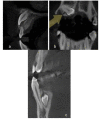CBCT Assessment of the Anatomical Characteristics of Gubernacular Canal in Impacted Teeth
- PMID: 36864997
- PMCID: PMC9971609
- DOI: 10.30476/DENTJODS.2021.92400.1638
CBCT Assessment of the Anatomical Characteristics of Gubernacular Canal in Impacted Teeth
Abstract
Statement of the problem: Gubernacular canal (GC) is a canal that extends from the follicle of unerupted permanent teeth to the alveolar bone crest filled with remnants of the dental lamina. This canal is thought to guide tooth eruption and be related to some pathologic conditions.
Purposes: This study aimed to determine the presence of GC and its anatomical characteristics in teeth, which failed to erupt normally on cone beam computed tomography (CBCT) images.
Materials and method: This cross-sectional study evaluated CBCT images of 77 impacted permanent and supernumerary teeth obtained from 29 females and 21 males. The frequency of GC detection, its location in relation to the crown and root, the anatomical surface of the tooth from which the canal has originated, and the adjacent cortical table to which the canal opens, along with the length of the GC were studied.
Results: GC was observed in 53.2% of teeth. The anatomical tooth aspect of origin was occlusal/ incisal in 41.5% and crown in 82.9% of teeth. Moreover, 51.2% of GCs opened in palatal/lingual cortex and 63.4% of canals were not located along the tooth long axis. Finally, GC was detected in 85.7% of teeth undergoing the crown formation stage.
Conclusion: Although GC was introduced as an eruption pathway, this canal is also present in impacted teeth. This means that presence of this canal does not promise the normal eruption of tooth and the anatomical characteristics of GC may influence the eruption process.
Keywords: Dental Follicle; Eruption Pathway Cone Beam Computed Tomography; Gubernacular Canal; Tooth Eruption; Tooth Impaction Impacted Tooth.
Copyright: © Journal of Dentistry.
Conflict of interest statement
The authors declare that they have no conflict of interest.
Figures
Similar articles
-
Association between gubernacular canals characteristics and teeth eruption status: a cone-beam computed tomography study.J Clin Exp Dent. 2024 Feb 1;16(2):e145-e150. doi: 10.4317/jced.61169. eCollection 2024 Feb. J Clin Exp Dent. 2024. PMID: 38496806 Free PMC article.
-
Detection of the gubernacular canal and its attachment to the dental follicle may indicate an abnormal eruption status.Angle Orthod. 2019 Sep;89(5):781-787. doi: 10.2319/090518-651.1. Epub 2019 Mar 11. Angle Orthod. 2019. PMID: 30855183 Free PMC article.
-
CBCT assessment of gubernacular canals in relation to eruption disturbance and pathologic condition associated with impacted/unerupted teeth.Oral Surg Oral Med Oral Pathol Oral Radiol. 2019 Feb;127(2):175-184. doi: 10.1016/j.oooo.2018.09.007. Epub 2018 Sep 26. Oral Surg Oral Med Oral Pathol Oral Radiol. 2019. PMID: 30482737
-
Imaging characteristics of Gubernacular Tract on CBCT- A pictorial review.Oral Radiol. 2021 Jul;37(3):355-365. doi: 10.1007/s11282-020-00461-y. Epub 2020 Jun 30. Oral Radiol. 2021. PMID: 32607940 Review.
-
Study and evaluation of the gubernacular canal by means of cone beam computed tomography.Stomatologija. 2020;22(3):86-91. Stomatologija. 2020. PMID: 33821813 Review.
Cited by
-
Assessment of gubernacular canal frequency with CBCT in a group of Turkish population.BMC Oral Health. 2023 Nov 13;23(1):861. doi: 10.1186/s12903-023-03608-5. BMC Oral Health. 2023. PMID: 37957628 Free PMC article.
References
-
- Massler M, Schour I. Studies in tooth development: Theories of eruption. Am J Orthod Oral Surg. 1941; 27: 552–576.
-
- Ferreira DCA, Fumes AC, Consolaro A, Nelson-Filho P, Queiroz AMd, Rossi AD. Gubernacular cord and canal: does these anatomical structures play a role in dental eruption? RSBO (Online) 2013; 10: 167–171.
-
- Cahill DR, Marks Jr SC. Tooth eruption: evidence for the central role of the dental follicle. J Oral Pathol Med. 1980; 9: 189–200. - PubMed
-
- Carollo DA, Hoffman RL, Brodie AG. Histology and function of the Dental Gubernacular Cord. Angle Orthod. 1971; 41: 300–307. - PubMed
-
- Nishida I, Oda M, Tanaka T, Kito S, Seta Y, Yada N, et al. Detection and imaging characteristics of the gubernacular tract in children on cone beam and multidetector computed tomography. J Oral Surg Oral Med Oral Pathol Oral Radiol. 2015; 120: e109–e117. - PubMed
LinkOut - more resources
Full Text Sources
Research Materials
Miscellaneous


